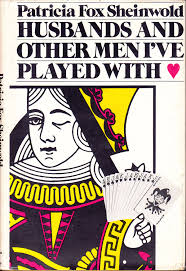Source: SI Vault Dec, 1976
H
usbands and Other Men I’ve Played With (Houghton Mifflin) is a bridge book—let’s get that straight right away. If you don’t play the game, move on, it’s not for you. But for those who do, whether beginner or expert, Husbands offers many insights into the world of big-league bridge as seen by the author, Patricia Fox Sheinwold, who was once married to one of the biggest of all big-leaguers, bridge columnist Alfred Sheinwold.
What you get in Husbands is a series of bridge lessons loosely disguised as Pat Sheinwold’s autobiography. For instance, we see her as a girl getting a chance to play in the kitchen with the family cook, chauffeur and maid, because the butler was away—daddy was obviously well-heeled—and it is in this game that she stumbles on the holdup, one of the basics in no-trump play, because the chauffeur (an opponent) too obviously wants her to play an ace at the first chance.
Later she starts playing tournament bridge, marries, has a child, gets divorced, marries Alfred, moves to California and plays bridge with the likes of John Wayne, Gregor Piatigorsky, Jascha Heifetz, Omar Sharif and Buster Keaton. Once, while pregnant, she is kicked by the baby just as she is about to make a faulty lead. She corrects herself, leads properly and gets the hand. In the meantime, the autobiographical part of the book is not abridged, and we learn that the world of tournament bridge should be X-rated at times; between marriages she accepts a man’s offer to be his partner and discovers later he means bed as well as board. She falls instantly in love with one opponent, deftly sets him in a small contract, then evidently soothes him upstairs—the scene is described in cutesy bridge terms: “His demands were strong, no weak preempts…. Every finesse worked…all four hands were exposed.”
However, she is at her best when telling stories or discussing the famous people she has sat down with at the bridge table. At one time her favorite partner in mixed pairs was a black dentist—”Do you play all the red suits while he plays all the black ones?” someone sniped—and she points out that bridge, like just about everything else in the country, did not become fully integrated until quite recently. We are introduced to Alvin Roth, perhaps the best bridge mind in the world, who once agreed to play with his wife in a charity event so long as she obeyed one rule: she could only bid clubs. She did and they won. The next year he allowed her to add diamonds to her repertoire, and they finished second, so he cut her back to clubs.
The playing styles of the celebrities Pat Sheinwold has encountered tend to match their public personalities. John Wayne, for instance, opens on 12 measly high-card points and barrels into four spades holding only five to the queen. He is doubled but makes the hand with the aggressive style of Rooster Cogburn. (We learn nothing about bridge from this, except that when John Wayne plays a hand, trumps break 3-3.)
Piatigorsky, the cellist, defends a hand that seems cold, but when he leads an unprotected king right into the teeth of dummy’s ace, the music stops for declarer. But the most entertaining hand is played by Keaton, a comic at the table, too. Ms. Sheinwold defeats him on one hand, and he reaches to the floor for an imaginary custard pie, which he throws in her face. Then there is this hand:
Opening lead:

10
Keaton studied the dummy a few seconds, then simultaneously dropped both red kings on the table—the diamond to take the first trick, the heart to lead on the second. It was the only lead that could have guaranteed the contract. Had he led a small heart, East (Pat Sheinwold) would have won the trick and shot back a trump through the ace-queen, shortening dummy’s trump. With Alfred Sheinwold forced to take the trick with his ace (and he was marked with it on the bidding), he could not lead a trump without giving up the king.
A little lesson with a little humor, which pretty much sums up the book.
Don’t forget to follow us @
 10
Keaton studied the dummy a few seconds, then simultaneously dropped both red kings on the table—the diamond to take the first trick, the heart to lead on the second. It was the only lead that could have guaranteed the contract. Had he led a small heart, East (Pat Sheinwold) would have won the trick and shot back a trump through the ace-queen, shortening dummy’s trump. With Alfred Sheinwold forced to take the trick with his ace (and he was marked with it on the bidding), he could not lead a trump without giving up the king.
A little lesson with a little humor, which pretty much sums up the book.
Don’t forget to follow us @
10
Keaton studied the dummy a few seconds, then simultaneously dropped both red kings on the table—the diamond to take the first trick, the heart to lead on the second. It was the only lead that could have guaranteed the contract. Had he led a small heart, East (Pat Sheinwold) would have won the trick and shot back a trump through the ace-queen, shortening dummy’s trump. With Alfred Sheinwold forced to take the trick with his ace (and he was marked with it on the bidding), he could not lead a trump without giving up the king.
A little lesson with a little humor, which pretty much sums up the book.
Don’t forget to follow us @

















 THE EX-WIFE OF A BRIDGE COLUMNIST DEALS AN INSIDE HAND ON THE GAME
THE EX-WIFE OF A BRIDGE COLUMNIST DEALS AN INSIDE HAND ON THE GAME










